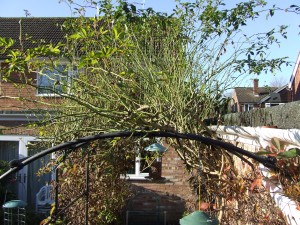The end of January/February is the time to prune your climbing roses to encourage lots of flowers in the summer.
Roses have a ”thing” called apical dominance. In very basic terms it means the main shoot is dominant and wants to reach the stars as quickly as possible. It is the main shoot that will flower.
The problem with this is that the sideshoots don’t develop leaving you with one or two stems and flowers only at the top. To get flowers and more stems lower down we have to cheat the plant into thinking it has several main shoots.
To do this we restrict the flow of sap up the main stem either with the main shoot at an angle between horizontal and 45° or gently wound around the pillar on an arch to create a framework.
Still with me?
Don’t worry too much about the science bit. If you have a new climbing rose it is easy to establish a framework. As the new shoots grow, and whilst they are still quite springy, gently ease them towards the position you want and tie them onto a support. It is best to tie them with garden twine as this will rot and break as the plant grows, in case you forget to loosen them as the stem gets bigger.
If you have an older plant it is best tackled in early Spring and may take a couple of years to really get the framework established. It may involve quite a bit of cutting but don’t panic. Once Spring gets going your rose will soon leap into renewed life, especially if you help it along with some rose feed as the growing season begins and mulch with some compost or well-rotted manure.
Choose the stems you can tie in at more or less the angle you want. Remove any crossing stems (where one stems sits across another or may rub on it), dead or diseased shoots. Where there are a couple of shoots together remove the weaker one.
Once you have chosen and tied-in your main stems shorten all the existing sideshoots. In summer all the side shoots along the angled main shoot will “think” they are the main shoot. They will then flower giving you flowers along the whole stem and filling your trellis or arch with colour.
I have taken the rose back to its main framework and removed any damaged/dead wood and any crossing stems to allow plenty of light and air around the plant. After pruning the rose is mulched with plenty of well-rotted manure. This gives it a bit of a feed and also helps retain moisture as we head into summer. In summer the arch is covered in white roses.

This last photo is another rose I pruned where you can see the sideshoots have produced flowers the length of the main stem.


